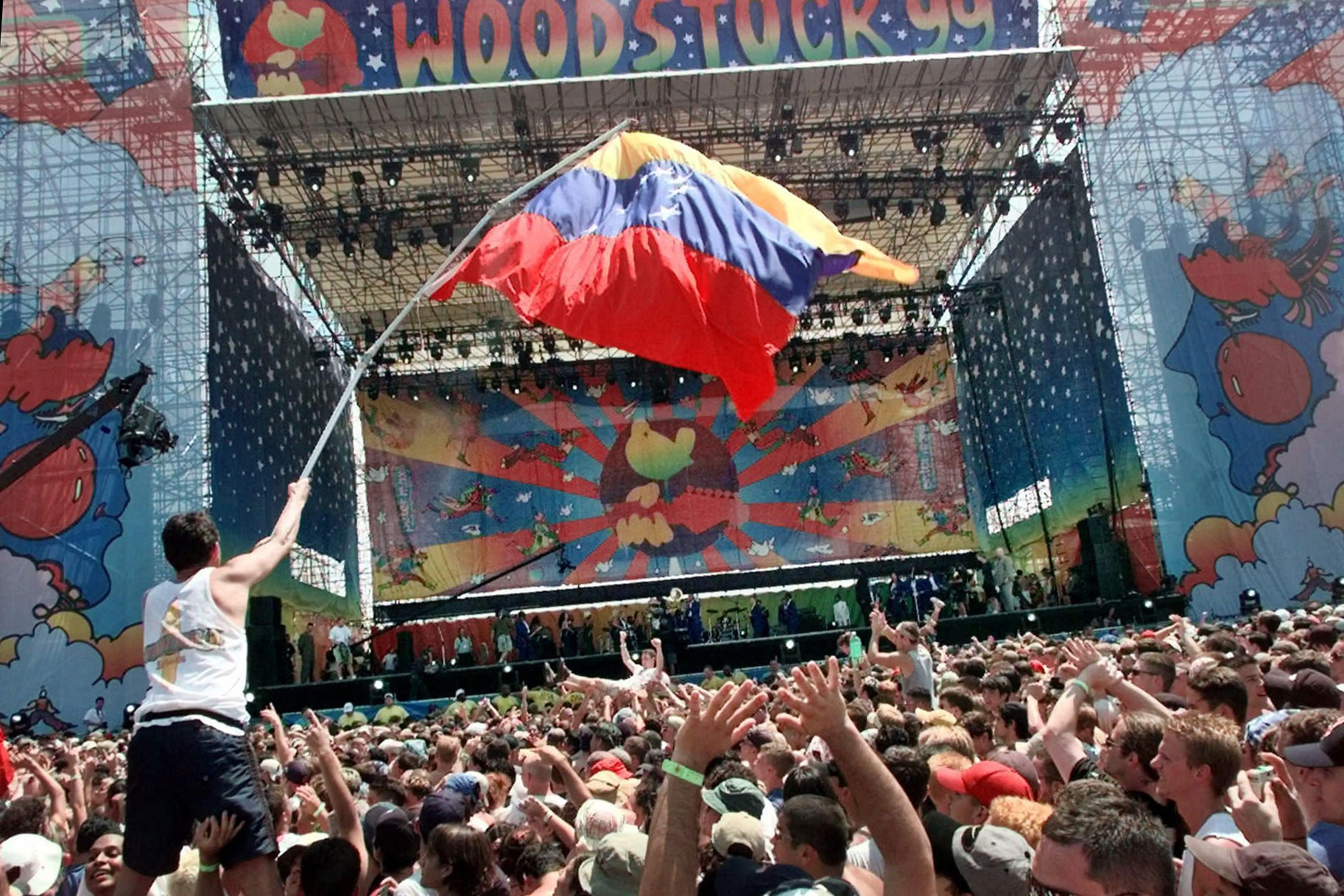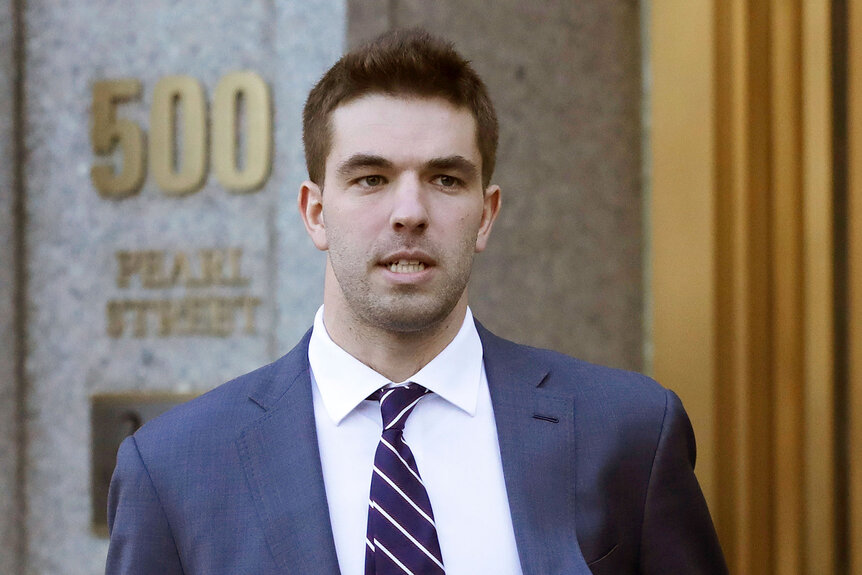Create a free profile to get unlimited access to exclusive videos, breaking news, sweepstakes, and more!
How Does Woodstock '99 Measure Up To Fyre Festival As A Concert Disaster?
“Woodstock ‘99: Peace Love And Rage” details the chaos of Woodstock '99, but it's hardly the only music festival debacle.

HBO’s new documentary “Woodstock ‘99: Peace, Love, And Rage” details the disastrous nature of that concert, which ushered out the 1990s with a display of chaos and violence. Of course, when reflecting on concert disasters, it's hard not to think of a more recent debacle, 2017's ill-fated Fyre Festival. So how do the two catastrophes stack up against each other?
Both went up in smoke. While one festival ended in literal flames, the other — aptly named Fyre — fizzled out in fraud charges. The notorious fests — held 18 years apart — serve as examples of what not to strive for when planning any sort of event. But as the new documentary clearly shows, Woodstock ‘99 had more dire consequences. But just how much more dire was it? We’ve broken down the two events, beginning with Woodstock.
Woodstock ‘99
What was it billed as?
Woodstock ‘99 aimed to be a four-day music festival that would recapture the magic of the original 1969 concert and become a landmark event for a new generation. After all, Woodstock ‘94, held just five years prior, was regarded as successful and peaceful. Organizers booked some performers based upon nostalgia from the original concert, like Willie Nelson, but they mostly featured contemporary bands at the height of their popularity. For 1999, that meant a lot of nu-metal acts like KoRn and Limp Bizkit.
Where was it held?
While the original Woodstock festival was held in the upstate New York town of Bethel, this fest was held about 100 miles away in town of Rome, NY. Instead of being held on a farm like in 1969, the 1999 version was held at the site of the old Griffiss Air Force Base. The B-52 bomber base closed in 1995 and it was converted to a business and technology park. Much of the appeal of the base was the gates; with both Woodstock ‘69 and ‘94, event-goers knocked down the fences, allowing hundreds to get in for free.
How much did it cost?
Tickets were $150 and $180 at the gate.
When did it take place?
The concert was staged in the middle of summer, from July 22 to July 25.
How many people attended?
More than 200,000 people showed up, the Washington Post reported.
What went wrong?
To begin, a whopping 10,000 people sought out medical attention, according to the AV Club. About 700 people were treated for heat exhaustion and dehydration, according to TIME. Temperatures skyrocketed into the 100s during the festival and there was barely any relief from the scorching sun; there was no shade, just long stretches of asphalt. In fact, festival goers had to walk about 1.5 miles on asphalt between the two main stages. The documentary shows images of people laying under trucks to cool down.
Amid the sweltering temperatures, bottles of water were being sold for $4 a pop and anyone trying to bring in outside water got their supply confiscated. There was a supply of free water, tubs of it, but overheated attendees began jumping into the water fly and cutting the pipes after getting tired of waiting in line for free water. One of the burst pipes contributed to the flooding of the porta potties, which were already overflowing; while some thought they were rolling around in mud, they were actually covered in human excrement.
Several of the performances became ridden with violence. Hundreds of injuries were reported during the Limp Bizkit set alone, MTV reported in 1999. During the performance of the band’s song “Break Stuff,” people in the crowd began ripping apart parts of the stage and then crowd surfing on the plywood.
By the end of the event, angry concert goers ripped apart the stages and started numerous large and dangerous fires — many were ignited with candles that were intended to mourn the victims of the Columbine shooting, which occurred three months prior. Riots and looting ensued, and vendor trucks were burned. Vendors lost millions, according to the Washington Post. Some of the concertgoers blamed the riots on the jacked-up water prices and poor festival conditions. Forty-four people were arrested by the end of the event, according to Rolling Stone.
As the documentary shows, women were constantly groped at the festival without consent and objectification of women was rampant. Four rapes were officially reported, the New York Times reported in 1999. Two women were allegedly raped in mosh pits, according to MTV. In both those instances, multiple men allegedly raped the women as the crowd cheered them on. Liz Polay-Wettengel, an attendee who set up a website for survivors after the concert, says in the documentary that dozens and dozens came forward to her anonymously to say they were also sexually assaulted. Of the 44 arrests, only one person was arrested in connection to a sexual assault. In that incident, a 26-year-old prison guard was accused of sexually assaulting a 15-year-old girl, the New York Times reported.
Three people died at the festival, MTV reported in 1999. One died of hyperthermia, another of cardiac arrest and a third was hit by two cars on a nearby highway.
What was the fallout?
The "Woodstock" brand of peace and love was soiled. Ironically, some of the notorious elements of Woodstock ‘99 actually mirrored the original event. At the 1969 concert, a food cart was set aflame after people became enraged with jacked up prices, according to CBC. While no violence was reported, at least two deaths were reported. One person died of an apparent drug overdose and another died after they were accidentally run over by a tractor while sleeping.
Fyre Festival
What was it billed as?
Fyre Festival was billed as an exclusive luxury three-day weekend in a tropical paradise. Influencers and supermodels, including Kendall Jenner and Bella Hadid, were paid to advertise the event. An early promo for Fyre Festival claimed that the exclusive party would be held on infamous drug cartel head Pablo Escobar’s private island in the Bahamas and that attendees would be flown in on private jets and that they would stay in villas and eat gourmet food. Supermodels were featured in the promo for the 2017 event, which ultimately went down in history as another disaster.
Where was it held?
The advertised island, Saddleback Cay, was not actually owned by Escobar and Bahamian authorities specifically asked the festival organizers to not mention the drug lord in the promotion, according to Business Insider. Because they didn't listen, they were then banned from using the island and held the event on Great Exuma, another Bahamas island instead.
How much did it cost?
Tickets cost between $1,000 and $12,000.
When did it take place?
The festival was scheduled to take place over two separate weekends in the spring of 2017, April 28 to April 30 and May 5 to May 7, but problems began immediately as attendees started arriving April 27. People were looking for a way off the island by the next morning.
How many people showed up?
Around 5,000 tickets were sold.
What went wrong?
There were no private jets; attendees were stuck at the Miami airport for hours before boarding 737s. When they arrived at the island, they found FEMA tents instead of luxury villas, and a dire lack of toilets. As the Netflix documentary “Fyre: The Greatest Party That Never Happened” shows, the weather conditions were not appropriate for camping; it was hot and full of mosquitos. Most of the booked bands, like Blink 182, pulled out before the festival even began. As for that luxury food, it didn't quite measure up. A lawsuit claimed that “accommodations were uninhabitable, including bug infestation, bloodstained mattresses and no air conditioning,” Mashable reported in 2017. Many attendees scrambled to leave as soon as they arrived.
While nobody died and there was no reported violence, a $100 million class-action lawsuit compared the festival to “Lord of the Flies.” Many of the beds were soaked and the tents were filled with mud. There weren't even enough beds and tents for guests. During the very first night, some looting ensued, according to the Netflix documentary.
What was the fallout?
Even as the event was going on, the festival became fodder for jokes and memes; shocking images of the "luxury" festival, including images of a depressing-looking cheese sandwich went viral.
The event’s organizer, Billy McFarland, pleaded guilty in 2018 to one count of wire fraud for defrauding investors out of $26 million for the festival. He was also convicted of a second count of wire fraud related to a scheme to defraud a ticket vendor. He was sentenced to six years in prison and ordered to forfeit $26 million.
Earlier this year, a class-action settlement was reached in U.S. Bankruptcy Court that would allow 277 ticket holders to receive more than $7,000 each, according to National Public Radio.


























